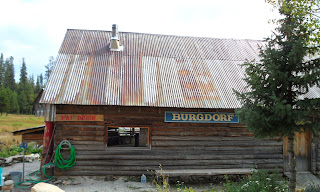He is buried in a small private graveyard in the small mining town of Warren Idaho. My brother visited the grave a couple of years ago and mentioned at a family reunion this summer that the graveyard was in disrepair, and his grave was in danger of becoming unmarked.
This is one of the old graves in the graveyard that can no longer be identified.
Three of my cousins and I decided that we should replace the grave marker and arranged a trip to Idaho for right after Labor Day. Two cousins came from Seattle, and one from Oregon, and Ron and I came from Granite Falls, WA.
My son and his family decided to join us on our adventure, and we all met in the closest big town, McCall, Idaho where we rented a big house where we could all stay together. Everyone brought old family photos and documents they had inherited that pertained to the family history.
Tuesday evening, we sat around the campfire and plotted our trip. Ron and I had carved a new headstone from a beautiful piece of black cherry wood that my brother, David, supplied.
After a nice breakfast, we stopped by the Ranger Station and picked up 3 CD's with a tour from McCall to Warren narrated to match mile markers and stops along the 50 mile trip. With 4 people in 3 different cars, we began our journey.
The drive begins in McCall, and winds along Payette Lake for many miles.
The headwaters of the Payette River, which feeds into Payette Lake.
Over 300,000 acres burned in the lightning sparked fire of 1994. New trees and undergrowth are just now beginning to return.
Sara and Jesse looking for the legendary Loch Ness monster in Lake Payette.
We stopped often to look at the amazing scenery and listen to the CD explaining the history of the area.
As we neared Warren, we began to see the mounds of rocks that had been dredged in the search for gold. At the height of the gold rush in the area, a 3 story high dredge was brought to the river and many millions of dollars of gold was extracted. The community at that time consisted of Chinese laborers and gold miners from both sides of the civil war. The settlers established two communities - one made largely of secessionists, named for the southern capital, Richmond. The other community named Washington, consisted of union sympathizers. Eventually, Richmond was demolished when a strong gold vein was discovered beneath the city. Washington was eventually renamed Warren.
While a lot of the buildings make the town look like a ghost town, the full time residents assured us that Warren is still a working mining town.
This picture no way illustrates the steepness of the trail to the graveyard in Warren. Somewhat daunted, we all headed up the hill to see if this was indeed the right trail.
Oh, dear, this is the trail. We bravely headed up wondering how on earth we could ever take the new headstone up that steep cliff. We had pretty much decided it couldn't be done, but Tony and Jesse insisted they would haul it up the hill.
Had we known how steep the hill was and how far the graveyard, we would never have encased the headstone in 4" of concrete. It must have weighed 150 pounds.
The new stone is in place, honoring our ancestor. Dates and facts verified by several sources, correct errors in the old marker.
On the way back, we stopped by Burdorf
For a rejuvenating dip in the natural hot springs.
Spotting a bear
and a pet bobcat(?!?!) on our way home was a fitting close to a truly remarkable day.



















Well, that was quite an adventure! A wonderful family experience. And about that bobcat...???
ReplyDelete